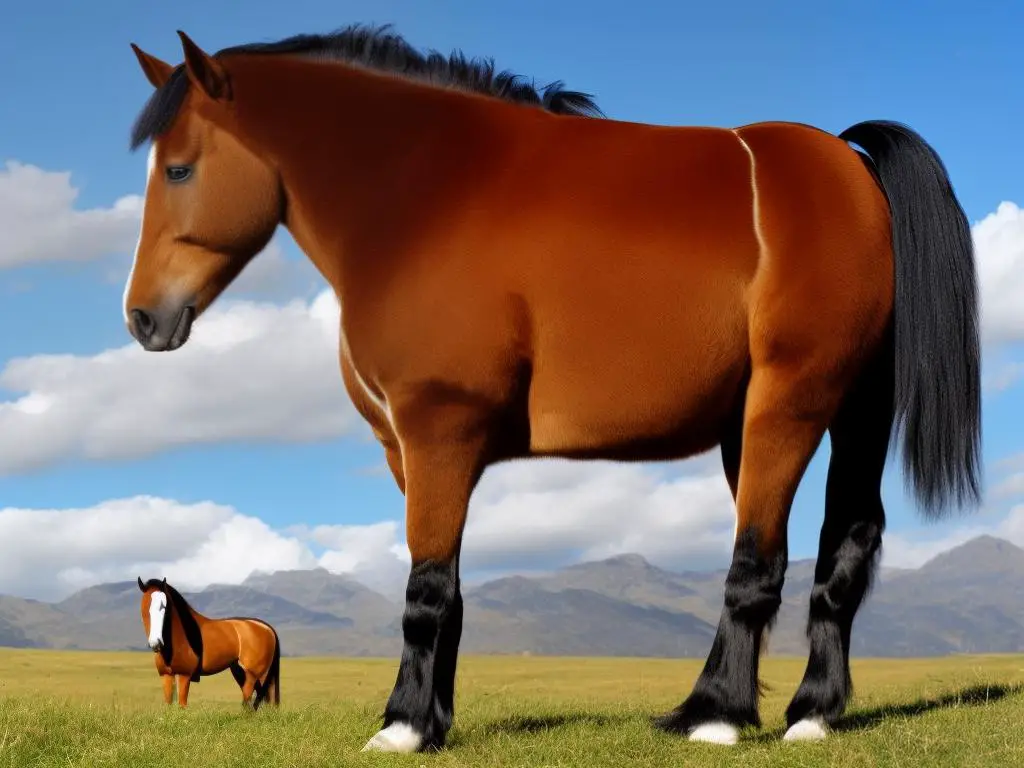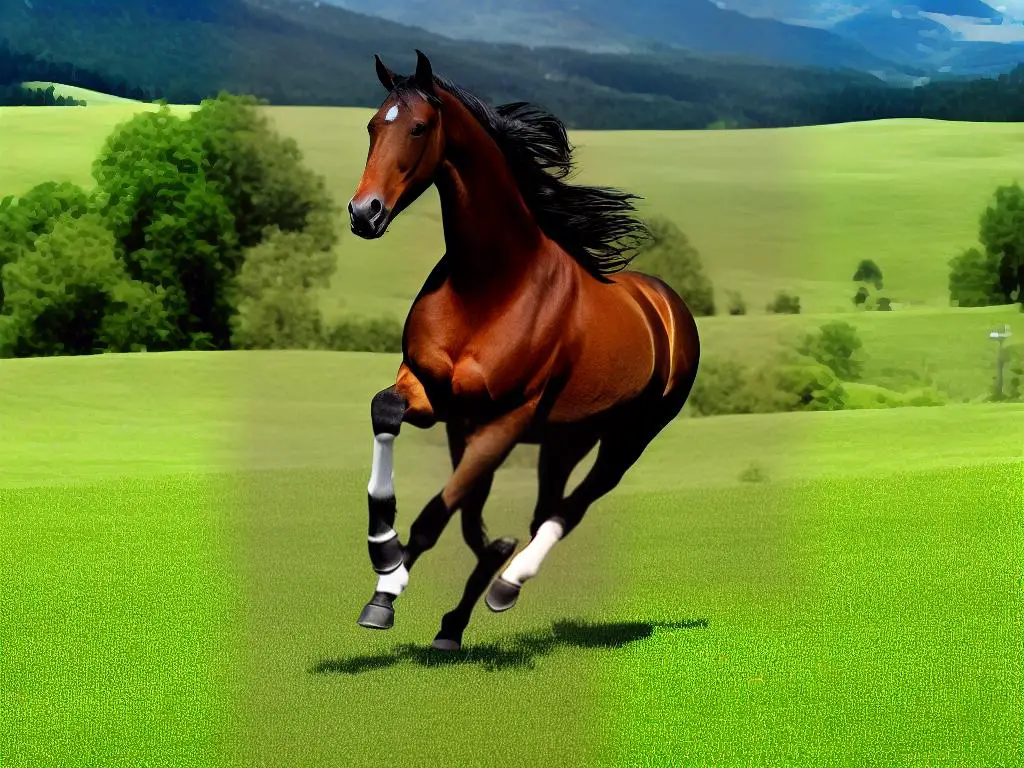The Westfalen Horse, a noble and versatile breed highly regarded in the equestrian world, carries a rich history and unique traits that set it apart from other breeds. Hailing from the Westphalia region of Germany, these horses showcase remarkable athleticism and elegance, making them standouts in various equestrian sports including dressage, show jumping, and eventing. This essay delves deep into the origins, physical characteristics, temperament, and modern uses of the Westfalen Horse, aiming to provide readers with a comprehensive understanding of this remarkable creature.
Table of Contents (Horspedia)
The Origin and History of the Westfalen Horse Breed
The Westfalen Horse Breed
The Westfalen horse breed, also known as the Westphalian, is one of Europe’s most prominent breeds. Highly prized for their exceptional athleticism, intelligence, and versatility, Westfalen horses are believed to have a history dating back to the 18th century.
Origins of the Westfalen Horse Breed
The Westfalen horse breed traces its roots back to the Westphalia region of Germany. The breed was first developed in the late 18th century at the state stud of Warendorf. The goal was to create a robust working horse that could be used for farming and heavy draft work. The foundation stock was largely made up of local Westphalian farm horses crossed with Thoroughbreds, Hanoverians, and Norman stallions.
Breeds Contributing to Westfalen Lineage
Many breeds contributed to the lineage of the Westfalen horse breed over the years. Initially, breeders used local farm mares and crossed them with imported Thoroughbreds, Hanoverians, and Norman stallions in a bid to increase their size, strength, and stamina. However, as societal and technological changes reduced the need for such heavy draft horses, breeders shifted their focus to developing sport horses. Hence, additional breeds such as the Anglo-Norman, Trakehner, and Holsteiner were later introduced, which greatly influenced the breed’s evolution into a modern sports horse.
Impact of Societal and Technological Changes
The Westfalen horse breed’s development was significantly influenced by societal and technological changes. As industrialization took hold in the 19th century and machines replaced horses for heavy draft work in agriculture, the breed’s role began to change. Breeders started focusing on producing versatile animals intended for riding and driving, which led to the Westfalen we know today – a horse breed renowned for its athleticism and suitability for various equestrian sports like dressage, show jumping, and eventing.
The later part of the 20th century saw further transformation as breeders started focusing on refining the breed to compete at the highest levels of equestrian sports. This was largely influenced by the increase in organized equestrian competitions worldwide.
Present-Day Westfalen Breed
Today, the Westfalen is one of the most prominent horse breeds in the world, appreciated for its athletic abilities, good temperaments, and versatility. These horses excel in a variety of equestrian disciplines, particularly dressage, show jumping, and eventing. The Westfalen studbook is very strict, allowing only approved stallions and mares to contribute to maintain the quality of the breed.
Conclusion
To put it succinctly, the Westfalen horse breed is a legacy that dates back to the 18th century, originating from the Westphalia region in Germany. Initially serving as workhorses, the breed has adeptly evolved with the changing societal needs and technological advancements to emerge as one of the top-tier sport horses in present times. The Westfalen’s blend of agility, intelligence, versatility, and sought-after temperament make it a top choice for equestrians worldwide.

Physical Characteristics and Temperament of the Westfalen Horse
Distinctive Characteristics of the Westfalen Horse
Famed for their robustness and agility, the Westfalen, also known as the Westphalian, is a stalwart breed from Germany. Established from crossbreeding local horses with Thoroughbred and Arabian stallions, Westfalens boast an appealing blend of elegance, strength, versatility, and endurance. Let’s dive into some of their physical attributes:
- Height is one striking feature, with mature Westfalen horses tipping the scale between 15.2 to 17.2 hands (approximately 62 to 70 inches).
- It’s common to observe that stallions, the males of this breed, stand taller and bear more muscle mass than their female counterparts, the mares.
- Their appealing heads, sculpted and expressive, are beautifully set on broad, deep chests and muscular necks.
- The Westfalen’s compact and muscular frame is characterised by a strong back and formidable hindquarters.
- They possess sturdy legs ending in durable hooves, adding to their agility.
- While these horses can be seen in a broad scope of solid hues, typical colorings are bay, chestnut, and gray, though black and white variants are quite common too.
Temperament and Behavioural Traits
The Westfalen Horse is as much admired for its temperament as it is for its physical attributes. It has a reputation for being calm, friendly, and highly trainable. Westfalens are known for their curiosity, intelligence, and willingness to work. They are eager learners who respond well to consistent training methods.
Despite their size and strength, Westfalen horses are generally good-natured and gentle, which makes them suitable for riders of various skill levels. They are versatile, which means they are comfortable with, and capable of, a range of equestrian activities.
Intelligence and Suitability for Work and Equestrian Sports
Westfalen Horses are highly intelligent and quick learners. This, combined with their physical strength and stamina, makes them ideal for various horse-related jobs and equestrian sports. Historically, they gained recognition for their use as carriage horses, but they have demonstrated their proficiency in an array of activities.
Westfalen Horses excel in dressage, jumping, hunting, and eventing. Their attentive nature, responsiveness, and the ability to remember lessons for long periods make them a preferred choice for competitive sports. Their elegance and graceful movements are particularly appreciated in the dressage ring.
Apart from sports, Westfalen horses are also used in various types of work, including agriculture and forestry projects. Their hardy nature, combined with power and endurance, make them capable of carrying heavy loads and performing physically challenging tasks.
Conclusion
Finishing off, the Westfalen Horse is a distinguished and versatile breed, identified by its robust physical characteristics and admirable disposition. These animals perfectly amalgamate strength, agility, intellect, and trainability, making them apt for diverse tasks, including farming labor to high-stakes equestrian competitions. Either you’re a seasoned equestrian hunting for an athletic ally or a beginner yearning for a mild yet zealous horse, the Westfalen breed is surely worth exploring.

The Westfalen Horse in Equestrian Sports and Modern Use
The Westfalen Horse
The Westfalen horse enjoys a notable position in the realm of equestrian sports and modern usage, showcasing its exceptional adaptability and skill set. Hailing from the Westphalia region in Germany, this warmblood breed is competitive across various sport disciplines such as dressage, show jumping, and eventing. Alongside being an exceptional athlete, the Westfalen horse is also celebrated for its superb temperament, making it a preferred selection among novices and professionals alike.
Role in Equestrian Sports
One particularly notable aspect of the Westfalen horse is its performance in equestrian sports. This breed excels in dressage, show jumping, and eventing owing to its stout build, agile movement, and high level of intelligence. Westfalen horses have repeatedly brought home medals in multiple international competitions including the Olympics. Much of this success is attributed to their flexibility, endurance and strong desire to perform, which enables them to gracefully execute intricate routines in dressage, effortlessly clear high obstacles in show jumping, and successfully navigate diverse terrain in eventing.
Modern Uses
Beyond competitive events, the Westfalen horse maintains numerous modern uses. Its soundness, good nature, and adaptability make it suitable for various activities beyond the show ring. These horses are proficient in pleasure riding, trail riding, and driving sports. Additionally, they have been increasingly utilized as therapy horses due to their calm temperament and ease of handling. The breed’s versatility has been well proven, with Westfalens also serving as police horses in some countries.
Suitability for All Levels of Riders
An attractive aspect of the Westfalen horse is its suitability for riders of all skill levels, from beginners and amateur riders to professional athletes. Their obedient nature, combined with their sensitive responsiveness, allows them to effectively partner with their human counterparts, learning and adapting to the riders’ skill. These traits make them an excellent choice for riding schools, where they help develop riders’ confidence and skills.
Popularity and Recognition
The Westfalen horse enjoys substantial popularity and recognition worldwide for its versatility, athleticism, and temperament. The Westfalen Studbook is one of the most respected breeding registries in the world and has branches in numerous countries, reflecting the breed’s international reach. Furthermore, Westfalen horses have had a profound impact on the equestrian industry, influencing the development of several other breeds.
Conclusion
The Westfalen horse is an extraordinarily versatile and capable breed that continues to leave an indelible mark in a variety of equestrian disciplines and roles. Its athletic prowess, combined with its even temperament, make it a well-rounded horse suitable for both sporting and non-sporting applications. Furthermore, its suitability for riders of differing skill levels, and its broad recognition and demand, both reinforce the timeless appeal of this distinguished breed.

Over the course of their storied history, Westfalen Horses have proven themselves as reliable, versatile and athletic equine partners. Whether on the dressage arena, eventing course, or bridle path, these hardworking equines combine beauty with performance, contributing to their consistent popularity among equestrians worldwide. As society and technology continue to evolve, so does the role of the Westfalen Horse, embracing new opportunities and challenges whilst retaining the timeless qualities that define their breed.